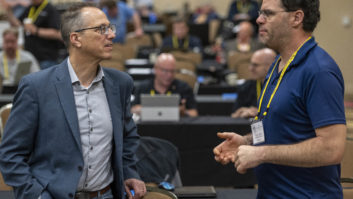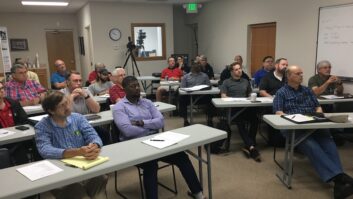A medium-market chief was reviewing weekend discrepancy reports on a Monday morning. This one, from a new weekend part-time operator, stood out:
“Whenever I turn the microphone on, the speakers shut off.”
Uh-oh. Can’t have that!
Here’s another from the “true confessions” file. A chief was awakened at home by an operator having some problem with the remote control. The chief, referring to the CRT-displayed remote control, asked, “What does the monitor say?”
The jock asked the chief to wait. Returning to the phone, he informed the chief that the monitor said “JBL.”
(click thumbnail)Wavetek has a new catalog.
Hey, remember when you had to pass an FCC test before being allowed on the air?
Tell us about your own “true confessions” and we’ll share them with readers.

. . .
Wavetek, the digital multimeter company, has released a new 20-page catalog that describes its portable DMMs and other electrical testers, kits, specialty probes and bench-top test and measurement equipment.
Call (877) 596-2680 for a copy.
. . .
We’re discussed the importance of keeping the transmitter well stocked and outfitted. Here are two more items for your list.
Do you have a stocked first-aid kit, mounted where it is clearly visible?
Do you have a trouble light with a long extension cord and a stock of spare bulbs?
Drop by a Lowes or Home Depot to find a large selection of trouble lamps, both fluorescent and incandescent types.
. . .
In a previous Workbench, we described a circuit for monitoring the status and failure of tower lighting (Oct. 23, 2002). This circuit also can be interfaced with the status inputs of a transmitter site remote control unit.
Tom Lange is with WSHS(FM) and the Sheboygan Area School District in Sheboygan, Wis. In his contract engineering days he designed a similar circuit, minus the 555 failure indicator, for WKTT(FM) in Cleveland, Wis. His circuit used a toroidal current sample transformer driving two switching transistors in a common emitter circuit.
Tom had these circuits set at different thresholds to indicate the activation of the tower lighting (presence of obstruction lamp current) and beacon (a rise in current when the beacon lamp flashed). The collectors were fed directly to the status inputs on a microprocessor-based remote control. These status inputs were +5 volt “pull-up resistor” inputs, so a power supply was not needed to operate the transistor circuits.
At the studio, the operator could observe that the tower lighting was functioning by seeing one status LED that glowed steadily and another LED flashing on and off on the studio remote control. If the beacon failed, the flashing LED would no longer flash.
If the obstruction lighting failed and the beacon was OK, both of the LEDs would flash. If none of the status LEDs lit, none of the tower lights were on.
Physical observation of lighting must be performed on a regular basis. This method, however, provides instant lighting failure notification.
Thanks, Tom, for a different twist — two LEDs — to monitor tower lights accurately. Anything to help the operators.
. . .
Owners of Powerware 9330 UPS units, take note. The company has discovered a problem with this model and the associated external battery cabinet. A safety notice has been sent to registered users (an important reason to fill out those warranty cards).
The company found that unapproved material and process changes were made by its battery vendor. The batteries in the UPS and external cabinets could leak, smoke and, in rare instances, cause internal fire.
The batteries must be replaced by trained technicians. Registered owners will be contacted with an aggressive remediation plan. Check the company’s Web site, www.powerware.com, for updates.
If you haven’t been contacted, call the Powerware Service Hotline at (800) 843-9433. You can register your UPS by clicking on the Safety Notice button at the company Web site.
. . .
If your transmitter and studio HVAC systems are serviced regularly, be sure to ask the technician to drop a few “Scum Buster” tablets in the condensate pan.
Algae can and will form in these pans. The growth eventually will block the condensate drain, causing a flood in your studio or transmitter area.
Make sure routine maintenance includes not only new filters but a forced air cleaning of the condensate drain. If you encounter an algae plug, before removing it press on it with your finger. You’ll be amazed at how strong those fibers are.
The Scum Busters prevent the formation of algae, keeping drains clear.
. . .
Ralph Jones of Entravision Radio in Sacramento read the March 1 Workbench describing tasks an engineer shouldn’t be asked to do.
He once posted a sign on his desk at a previous station. It read, “That’s Engineer, not MULE!”
Submissions for this column are encouraged, and qualify for SBE recertification credit. Fax your submission to (703) 323-8044, or send e-mail to [email protected].











